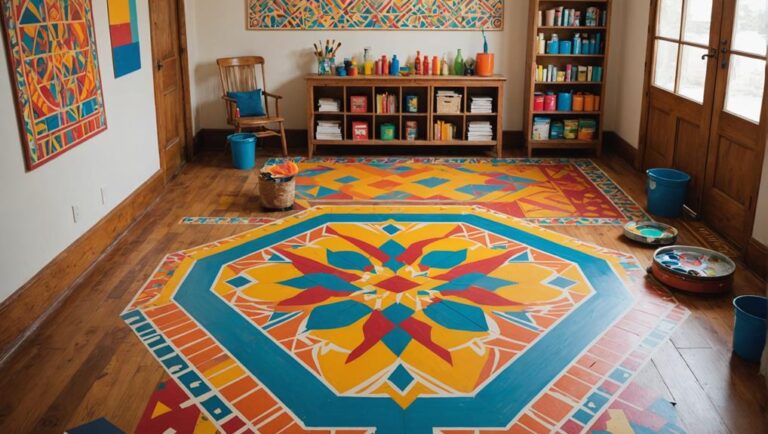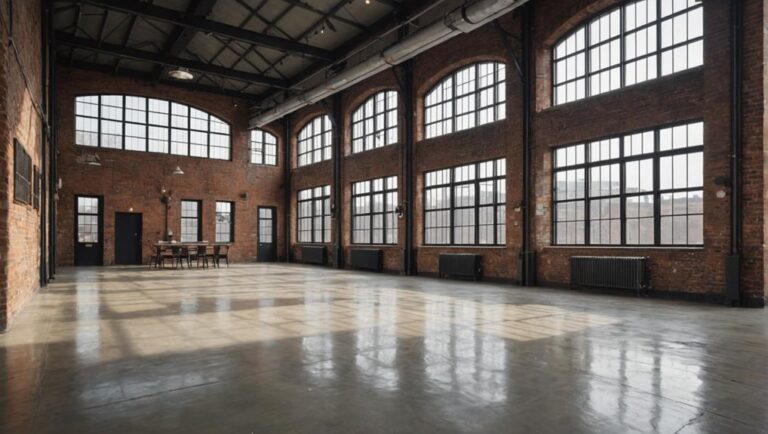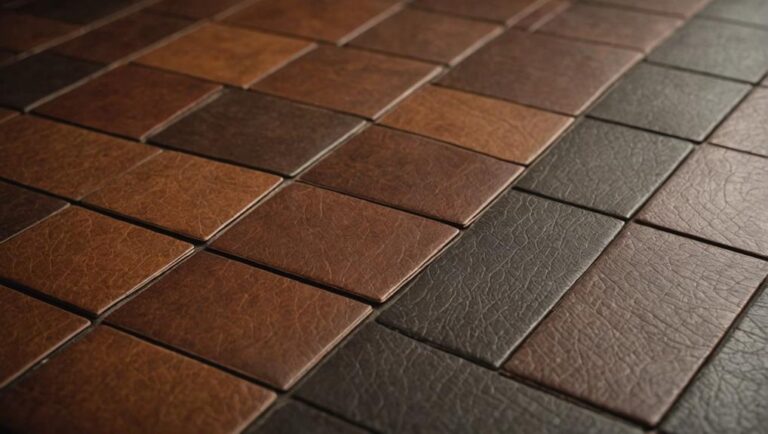To achieve a vintage look with modern floors, start by selecting materials that blend durability with classic aesthetics. Think engineered hardwood for warmth or luxury vinyl planks that mimic aged wood. Embrace retro patterns with slip-resistant tiles that echo historical designs. Incorporate warm tones like deep reds, layering textures for depth. Vintage decor can enhance the ambiance; antique furnishings and charming textiles serve as beautiful contrasts. Don't forget maintenance—regular cleaning and protective coatings keep your floors looking timeless. With these tips, you'll create a space that radiates nostalgic charm while enjoying modern comforts. Explore further to uncover more inspired details!
Choosing the Right Materials
When you're aiming to achieve that vintage look with modern floors, it's essential to narrow down your material options carefully. You'll want to take into account a blend of aesthetics and functionality, ensuring that your choice not only captures the charm of yesteryear but also stands the test of time.
One popular option is engineered hardwood, which offers the warm, inviting appearance of traditional hardwood while providing superior material durability. This type of flooring boasts a layer of real wood veneer over high-quality plywood, making it less prone to warping and scratching compared to solid wood. You'll find various finishes that mimic the rich patinas of vintage floors, allowing you to evoke a sense of history.
If you're leaning towards tile, porcelain and ceramic tiles can mimic the look of antique patterns without compromising on durability. They are resistant to moisture and wear, making them safe for high-traffic areas. Plus, with options that feature textured surfaces, you can enhance safety by minimizing slip hazards.
Lastly, think about luxury vinyl planks (LVP) for a versatile flooring solution. LVP offers a variety of designs that can emulate classic wood or stone, all while ensuring long-lasting performance. It's resilient and easy to maintain, making it a practical choice for families or pet owners.
Embracing Vintage Patterns
Incorporating vintage patterns into your flooring design can transform a modern space into a nostalgic haven. By choosing retro tile options, you can evoke the charm of yesteryear while guaranteeing safety and durability. Think of intricate designs featuring classic motifs such as florals, geometrics, or checkerboards. These patterns not only add visual interest but also create a tactile experience that invites exploration.
When selecting retro tile, consider materials that are slip-resistant and easy to maintain. Porcelain or ceramic tiles can provide the perfect blend of style and functionality. You'll want to ascertain that the finished floor meets safety standards, particularly in high-traffic areas. Look for products that feature a textured surface to help prevent slips and falls, giving you peace of mind while still achieving that vintage aesthetic.
Don't shy away from mixing various patterns and colors, either. Layering classic motifs can create a dynamic, personalized look that speaks to your unique taste. For example, you might pair a bold geometric pattern with a more subdued floral design, creating a harmonious balance that enhances the overall ambiance of your room.
Ultimately, embracing vintage patterns allows you to celebrate history within your modern home, creating a space that feels both timeless and inviting. By carefully selecting retro tile and guaranteeing safety and practicality, you can successfully achieve that sought-after vintage look without compromising on comfort or security.
Incorporating Color and Texture
To achieve an enchanting vintage look, adding color and texture to your flooring can make all the difference. The right hues can evoke nostalgia, while texture contrast creates a tactile experience that feels rich and inviting. Start by considering color psychology; warm tones like deep reds, muted greens, and soft yellows can instantly transport you to a bygone era. These colors not only enhance the vintage aesthetic but also create a cozy and welcoming environment.
Next, focus on texture. Combining different textures within your flooring can add depth and interest. For instance, pairing smooth hardwood with a rustic, distressed area rug can highlight the beauty of both materials. This contrast not only draws the eye but also guarantees safety by providing a non-slip surface in high-traffic areas.
Don't shy away from incorporating patterned tiles or textured vinyl planks that mimic the look of aged wood or stone. These options are durable, easy to maintain, and perfect for achieving that vintage vibe without compromising on safety or modern convenience.
To further enhance the effect, consider using finishes that add luster or a matte appearance, depending on the mood you want to create. A satin finish can give a subtle glow, while a matte finish emphasizes the natural beauty of the materials. By thoughtfully selecting colors and textures, you can create a timeless flooring that feels both modern and vintage, providing a safe and stylish foundation for your home.
Accessorizing for Vintage Appeal
While you may have chosen modern floors that exude elegance, accessorizing can elevate that vintage appeal and tie your design together. Start by selecting vintage decor that complements your flooring. Think about rich textiles, like velvet or brocade, in warm, muted tones to soften the sleekness of modern materials. Consider drapery that cascades down to the floor; these flowing fabrics can create a sense of nostalgia, easily merging the old with the new.
Next, introduce antique furnishings that tell a story. A rustic wooden table or a beautifully crafted sideboard can serve as focal points that draw the eye. When incorporating these pieces, confirm they're not overly ornate; a balance between vintage charm and modern simplicity can achieve a harmonious aesthetic.
Lighting also plays a vital role in your vintage theme. Opt for stylish sconces or a chandelier with a patina finish to cast a warm glow. Vintage-inspired light fixtures can enhance the ambiance, creating a cozy atmosphere that invites relaxation.
Don't overlook small accessories, either. Vintage books, a collection of delicate porcelain, or even an antique clock can add character without overwhelming your space. Arrange these items thoughtfully on shelves or tabletops to create visual interest.
Maintenance Tips for Longevity
Although modern floors can bring a sleek aesthetic to your home, maintaining their beauty requires some diligence. To guarantee your floors remain in top condition, develop a regular floor care routine that focuses on both cleaning and protection. Start by sweeping or vacuuming daily to remove dirt and debris that can scratch the surface. When mopping, use a damp mop with a pH-neutral cleaner specifically formulated for your flooring type—this helps prevent damage while keeping your floors sparkling.
Consider applying protective coatings to enhance durability and prevent wear. These coatings create a barrier against moisture, stains, and scratches, extending the life of your floors considerably. Check with your flooring manufacturer for recommended products, as using the wrong type can lead to complications.
In high-traffic areas, place rugs or mats to reduce the impact of foot traffic and protect your floors from scuff marks. Don't forget to regularly inspect your floors for any signs of damage, like scratches or dents. Addressing these issues early on can prevent further deterioration.
Lastly, be mindful of the temperature and humidity levels in your home. Extreme fluctuations can cause materials to expand or contract, leading to warping or gaps. Aim to maintain a stable environment to keep your floors looking their best.
Frequently Asked Questions
What Are the Best Flooring Options for a Vintage-Inspired Kitchen?
Picture stepping into a kitchen that whispers tales of yesteryear. For a vintage-inspired space, consider vintage tile; its ornate patterns can set the mood beautifully. Pair that with reclaimed wood for warmth and character, creating a harmonious blend of history and functionality. Make certain your choices are safe and durable, so you can cook with confidence. These flooring options not only evoke nostalgia but also make your kitchen a cozy, inviting haven.
How Can I Blend Vintage Floors With Contemporary Furniture?
To blend vintage floors with contemporary furniture, you'll want to focus on vintage color schemes that harmonize with your decor. Consider using neutral furniture in shades that complement the warmth of your vintage flooring. Incorporate modern accents, like sleek metal or glass accessories, to create contrast without overwhelming the space. Balance is key—you can maintain safety by ensuring pathways are clear, letting the vintage charm shine through your contemporary style.
Are There Specific Brands Known for Vintage-Style Modern Floors?
If you're looking for brands that offer vintage-style modern floors, consider those specializing in vintage tile and reclaimed wood. Many reputable companies focus on eco-friendly materials, ensuring safety while delivering charm. Brands like Shaw and Mohawk provide stunning options that replicate the rustic look of old-world floors. You'll find a variety of designs that evoke nostalgia, combining beauty with durability to create a warm, inviting atmosphere in your space.
Can I Achieve a Vintage Look on a Budget?
Yes, you can definitely achieve a vintage look on a budget! Start by exploring affordable materials like laminate or vinyl that mimic the charm of aged wood or tile. Use DIY techniques, like distressing or painting, to add character to your floors without breaking the bank. Consider layering rugs to enhance the vintage feel while ensuring safety with non-slip options. With a bit of creativity and effort, you'll create a stunning vintage vibe affordably!
What Common Mistakes Should I Avoid When Aiming for a Vintage Aesthetic?
When you're aiming for a vintage aesthetic, avoid common pitfalls like clashing color choices and mismatched texture combinations. Stick to a cohesive palette that reflects the era you're inspired by; muted tones often work best. Don't overlook the importance of layering textures to create depth and warmth, but make certain they complement each other rather than compete. Finally, be cautious with trends—what's modern might not translate well into a timeless vintage feel.




